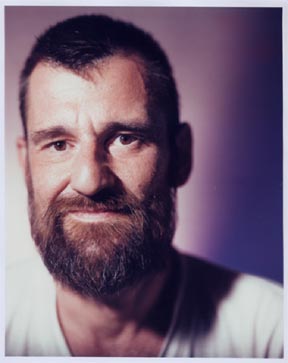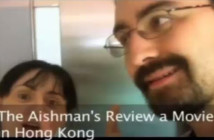I am writing this letter to Big Red because I realized the other day that I am stalking Bill Arning, the curator of the MIT List Visual Arts Center. I love the work he curates at various venues, I have followed his writing in art periodicals like Art in America and I have a substantial collection of the various catalogs for exhibitions he has written in. In fact they have their own special shelf. Next to his picture. And some candles. All of this seemed normal to me, but I realized that perhaps I crossed a line the other day when I found out that he was going to be on a number of panel discussions at this year’s College Art Association’s conference.
I found out when and where Bill was speaking and I went to hear the discussions. I have decided that I am intellectually stalking Bill because upon sitting down to listen to the panel, I realized that I had not even taken the time to find out what the panel was about. It also had not occurred to me that I was supposed to pay a $240 conference fee to attend the panels. I had just walked in, smiled at the guard in a way only the truly, blindly devoted can smile and then I just sat down. None of those trivialities mattered because Bill was talking …
I quickly discovered that the panel was called Curators as Critics and the whole panel discussion revolved around the issues of curators, like Bill, who also actively write criticism. The whole mood of the panel was strangely defensive, but apparently, it was defensive for a good reason. One person in the audience actually said that he was rather concerned about the very existence of the panel as the potential moral conflicts between being a curator and simultaneously being an active critic were simply too huge.
To be honest, this attitude shocked me because the main reason I read Big Red is that I view this publication as a venue for anyone including artists and curators to write criticism. While I am cognisant of the potential problems of this system, I see the potential benefits as being far greater.
As an artist, my relationship to art criticism is very specific and I recognize that criticism functions differently for different people. I think for a large number of people involved in the arts, criticism functions as a marketing tool and that is where the largest number of potential conflicts occur. There is a notion that the critic functions as a form of connoisseur which in today’s world is better described as an investment expert for the art market. Obviously if one views an art critic as an investment expert, then the conflict occurs where a critic who is a curator, artist, gallery owner, or anyone else who has a vested interest in the sales of art work would simply recommend that their work should be invested in. However, as an art maker, I don’t care that much about the market side of criticism a) because I believe that all critics have a vested interest in the art market in some way, either economically or politically, and b) because there are better ways to market art work than criticism.
I also have a number of artist friends who are completely uninterested in art criticism or writing or even other people’s exhibitions. They don’t read Big Red or any of the art magazines or catalogs or anything really. This is fine by me and it seems to work well for their artistic practice. However, for me, I view all of my work a large collaborative project that I put my name on in the end. I’m an artist because I love reacting to something by making something. It’s really that simple for me. I view criticism, not as a marketing tool, but as someone who saw something that made them want to react, so they wrote something about it. I can relate to that sentiment and that’s why I sometimes write for Big Red. That’s also why I love going to openings and reading reviews. I just want to be around people who react to the world by having to do something rather than being passive receptors. I need to live among the desperate.
_
That’s why I’m stalking Bill Arning. I’ve never asked him, but I think Bill just loves art. He doesn’t curate exhibitions or write about exhibitions because the market demands it, he writes and curates because when he sees something he likes, he reacts to it by having to do something ie. curate it into a show, write about it, talk about it, do a dance, something, anything. That’s why the work he does is so intelligent and well done. It’s genuine; it’s not forced like some other critics and curators who you can tell are working because they want recognition for how smart they are, not because they are actually reacting to the artwork. I love going to hear Bill talk because you can tell he’s so excited to talk about artwork that he can barely contain himself. Like a vampire, I feed off of that excitement and it makes me have to go make more of my own work.
It seems to me that the market is threatened by any form of artist/critic/curator like Bill and most of the people who contribute to Big Red because the divisions of labor in the art world are viewed as divisions of labor of legitimation and by hybridizing the divisions, we are undermining the legitimacy of the whole system. However, from my point of view the hybridizing of roles people play in the art market simply makes sense because none of us actually are our perceived roles, we’re just people reacting to things and participating in our community. Sometimes I’m a writer, sometimes I’m a teacher, sometimes I’m an artist, sometimes I’m a curator, it all depends how I feel like reacting to world around me at the time. The fact that I react in these different ways is normal. Isn’t it? I mean after all, who reacts to everything in the world in the same way all of the time?
I think this is where the greatness of Big Red really shines through. There are many venues for art criticism that support writing that is a reaction not to the artwork, but to the market. The style of criticism that is more about the marketing of artwork and that is less about someone needing to react to artwork, is not what I am interested in. I truly hope that Big Red becomes more punk rock in an intelligent, positive way. I assume that’s why the editors are advocating things like the Opening Night Quick Reviews of First Fridays in the Forum. Clearly, Big Red is dedicated to supporting people who go to First Fridays and see something that makes them want to explode if they don’t go home and write about it immediately. I hope to see more writing that is fueled by a deep desire to react to artwork by writing about it.
But maybe that’s just me. I have no idea what the editors are thinking the direction of Big Red should be. I have no idea why other people read Big Red. But I know why I read Big Red. And it’s because the writers are people who just have to react to something by writing about it. I love the opportunity Big Red has presented to participate in a community of creators. So thanks Big Red. And keep it up.
Links:
MIT List Visual Arts Center
College Art Association
The CAA session, Curators as Critics, was on Saturday, February 25, 12:30 PM–2:00 PM at the Hynes Convention Center.





